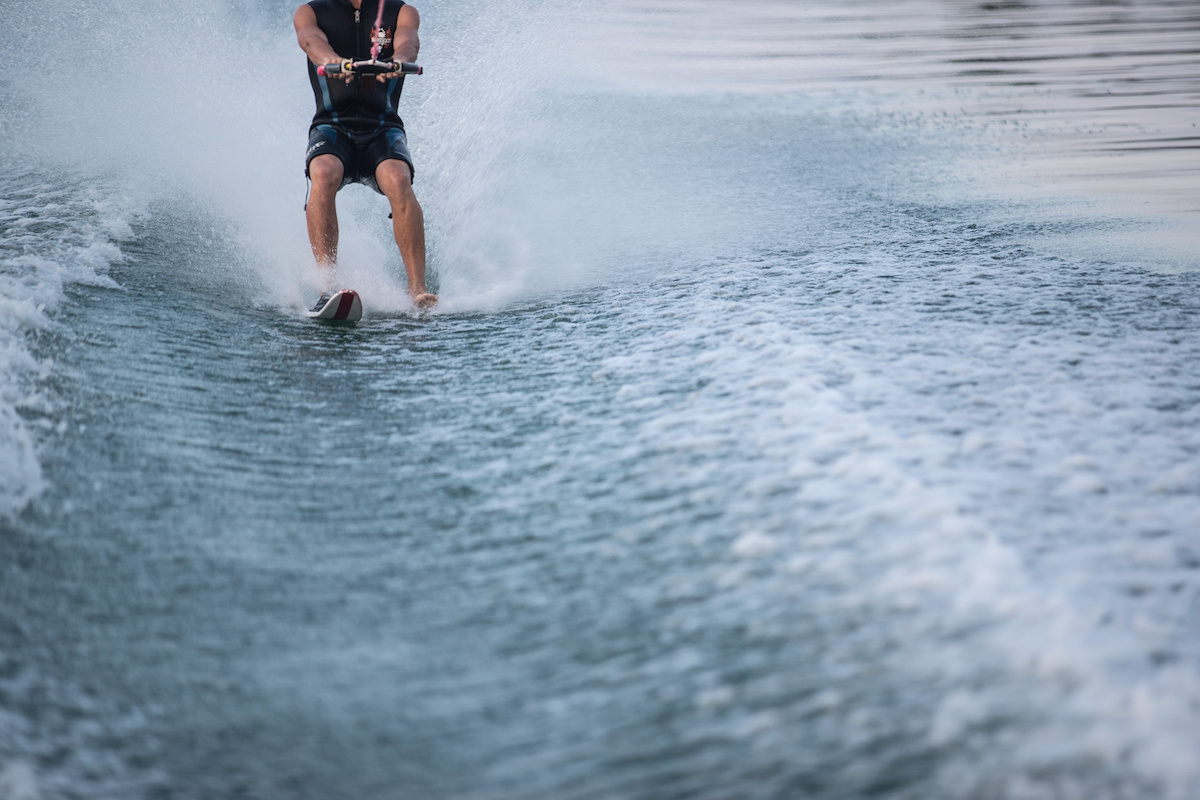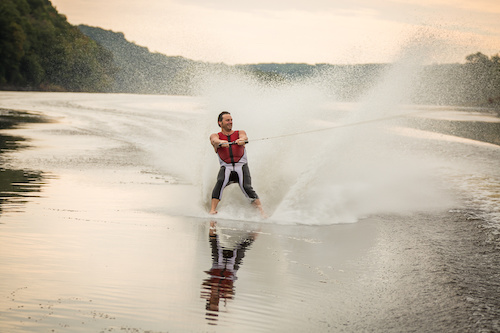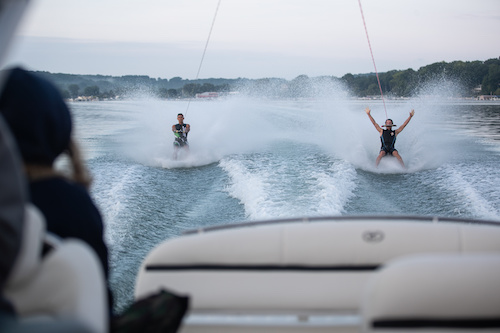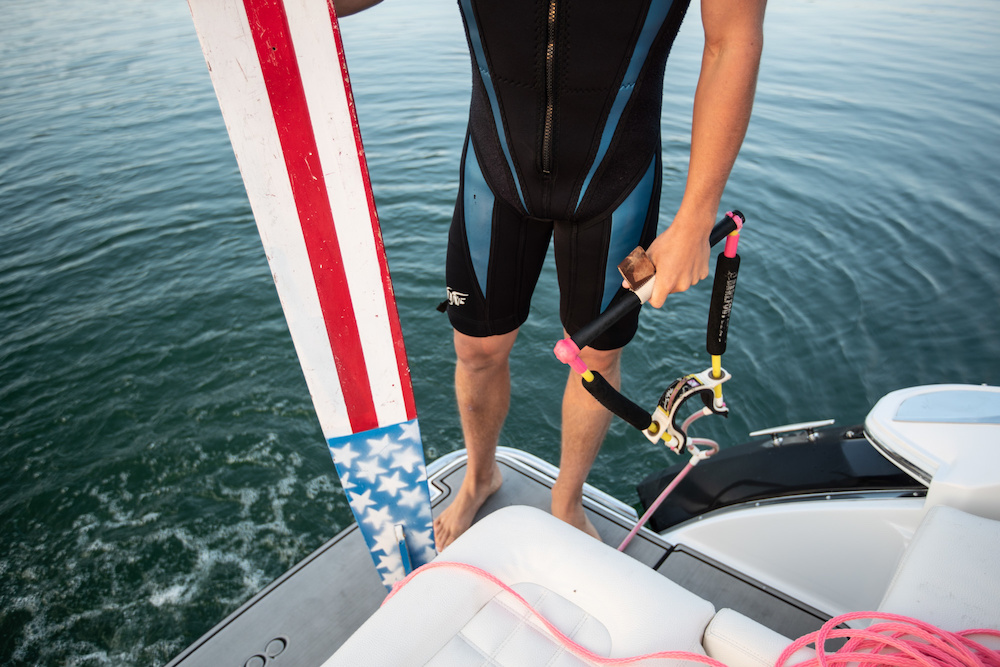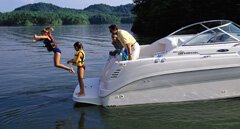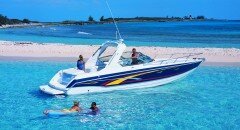Every highly engaging sport or hobby has the built-in capacity for escalation—that’s what makes it so engaging. From the moment you buy a boat, you’re thinking of your next boat, a bigger one, right? As soon as you learn to water ski, you’re looking for a slalom course. After that, you’re looking at trick skiing or maybe ski jumping, or more likely, you’re looking to go barefoot water skiing. Barefoot skiing is probably the most extreme version of the sport.
How to Barefoot Ski
- Start by using a "boom" that attaches to a ski pylon.
- Place your feet over the cable forward of the boom.
- Hold onto the boom as if you were holding the handle of a ski rope.
- For deep water starts, drive your hips vertically and lower your head and shoulders back into the water to plane out as the boat takes off.
- Once you are at speed, keep your legs over the cable and do a smooth, steady crunch to begin "skiing" on your bottom. Your feet will naturally slide rearward on the cable when you do this.
- Take your feet off the cable, still riding on your butt, and lower them towards the surface of the water—be deliberate and smooth.
- Remember to keep your knees together. You'll be gliding on your bottom and your feet at the same time.
- From that position, pull yourself up on the bar, and rise to the two-foot stance.
- Keep your back straight and extend your arms full, but do not lock your elbows.
- Accelerate to 20MPH for a bottom ride, then accelerate to 35 to 45 MPH (average barefoot speeds).
Explore Ski Boats & Wake Boats
You also can incorporate a wake skate into learning to do a deep-water barefoot skiing start, and this might be the most forgiving way to learn. Start by sitting about two thirds of the way back on the board, with your toes even with the front of the wake skate. As the boat takes off, put your feet on the outside of the skate to stabilize the board as it comes on plane. From there your feet are in the right position for you to stand. Remember to keep your knees together and your back straight.
The methods are largely the same for starting at the end of a short or long ski rope, but bear in mind you need to edge outside the wakes before you can stand up.
Barefoot Skiing Equipment
Like any other watersport, water skiing requires a fair amount of specialized gear, and some of it is different from regular water skiing equipment. To get out on the water to learn and enjoy some freestyle barefoot water skiing, you need the following items:
- Boat
- Barefoot ski boom
- Water ski rope and handle
- Barefoot wetsuit or padded trunks
- Barefoot water ski shoes
- Life jacket or PFD (personal floatation device)
- Helmet (optional)
Without a doubt, you need a boat to learn to go barefoot water skiing, but we’ll cover that in its own section further down in this story. For starters, let’s focus on getting you in the right gear.
A boom is the best way to learn to barefoot ski. It attaches to the ski pylon and extends off the side of the boat and is stabilized by cables that attach at the bow. It’s a great tool for learning because it puts you within eyesight and shouting distance of the driver and/or coach.
According to USA Water Ski, barefoot water ski ropes should be made from a low-stretch plastic or similar material and have been sufficiently pre-stretched so as to allow only minimal stretch. They also should have floating handles because once you’ve mastered the barefoot deep-water start with the boom, you can move back behind the boat and be towed with the rope.
For beginners, it’s best to learn while wearing a barefoot wetsuit, or a set of padded trunks. A barefoot skiing wetsuit helps you get on plane easier and minimizes the potential for, uh, injuries.
Beginners also can benefit from starting out on barefoot water ski shoes. They’re not expensive at less than $200, but they let the novice focus on form when learning starts and techniques.
The last essential water ski accessory is the life jacket or PFD, and the current generation is more comfortable than ever. Pricey vests can run a little more than $100, but don’t be afraid to spend more for a PFD that fits well. Bright colors are also a good idea for making a downed skier in the water more visible. A helmet is optional, but it’s a good idea for beginners and children.
Life Jackets, Vests & PFDs: How to Find the Right Fit
What Type of Boat Do I Need to Barefoot Water Ski?
Barefoot ski boats need to create small wakes and they need to be able to pull a barefoot skier up on a deep water start. They also need to be able to reach speeds up to 45 MPH. Barefoot water skiing speeds are higher than those for regular water skiing because it takes a bit more speed to keep a barefoot water skier on plane. Typically, the best boats for barefoot skiing are tournament inboards and outboard-powered boats designed for barefoot skiing.
Because barefoot skiers need more speed and flat wakes, outboard-powered boats and the smaller, lighter tournament inboards designed for slalom skiing are best. Bear in mind that an outboard will need to be more powerful than a regular runabout. Plan on something in the 175- to 225-HP range.
How to Buy a Boat for Watersports
Barefoot Skiing Speeds
The short answer for determining boat speeds for barefoot skiing is the heavier the skier, the faster you need to go. The more scientific approach is to divide your weight by 10, then and 20 to determine your speed.
| Weight (lbs)/10 + 20 | Speed (MPH) |
| 255/10 + 20 | 42.5 |
| 200/10 + 20 | 40 |
| 180/10 + 20 | 38 |
| 160/10 + 20 | 36 |
Frequently Asked Questions
What is barefoot skiing?
Barefoot skiing is exactly what it sounds like: water skiing without the skis. It’s also a whole lot of fun once you can do it reasonably well.
How fast do you have to go to barefoot ski?
Speeds vary with the weight of the skier. A decent range is from 30 to 45 MPH.
How to barefoot water ski without a boom?
It is possible to ski without a boom, but a boom is the best way to learn. Don’t attempt starts behind the boat at the end of the rope till you have become familiar with the fundamentals of form and technique.
How to barefoot ski with rope?
You must move outside the wakes before you can stand up, but as the boat takes off, drive your hips vertically and lower your head and shoulders back into the water to plane out and keep the spray out of your face. Once you are at speed, keep your legs over the cable and do a smooth, steady crunch to begin “skiing” on your bottom. Your feet will naturally slide rearward on the cable when you do this.
How to start barefoot skiing?
To learn how to barefoot ski by yourself, you’ll need a decent amount of gear, not the least of which is a boat that can pull a barefoot skier. Your best bet is to find a school that teaches barefoot skiing and get some good instruction. If you find that you like it, then you can invest in the equipment.
You Might Also Like:
